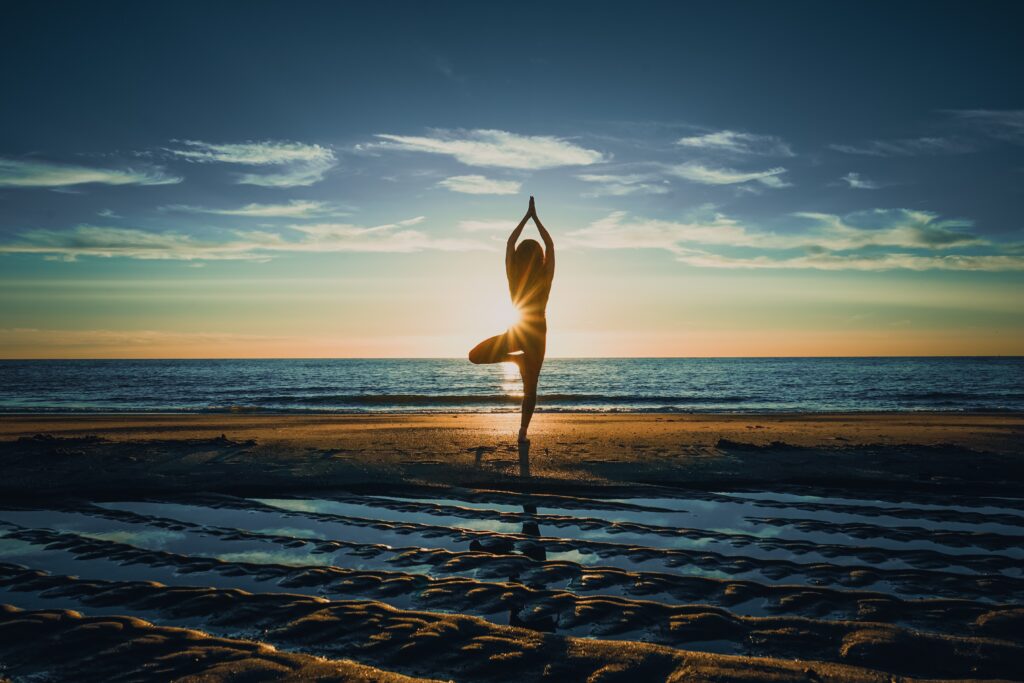Although widely popularized in the health club and fitness industry as a physical workout for toning and flexibility, it may surprise you to learn that yoga was never intended for use as a physical exercise. At least, not primarily. The fact is, the practice of yoga in this setting is typically quite effective in toning the physique. Anyone who has ever taken a yoga class at a gym is probably familiar with class names like core power, vinyasa flow, and hatha yoga, to name a few. Engaging in only these types of classes is wonderful if that is your preference. However, one who chooses not to go deeper into the practice is missing out on the majority of the intended benefits.
Depending on where the certification comes from, a 200-Hour Yoga Teacher Training (YTT) Certification course will teach you about the 5 branches and 8 limbs of yoga. What a student finds when studying this practice more in depth is that yoga is far more powerful and rewarding than just physical exercise alone. Let’s break those pieces down now.
The 5 Branches of Yoga
Yoga is a journey. A continuous practice that will gradually transform you from the inside out, helping you tap into better versions of yourself. Our thought energy is connected to our emotional energy, and both are connected to our consciousness and our physical bodies. The 5 branches of yoga are meant to harmonize all the different layers of our being.
- Hatha Yoga – this branch pertains to the physical expression of the practice. Emphasis on the exchange between heat and cooling. When tapping into hatha yoga, one is using the body to tap into the energies of the mind and spirit. Particular focus is on the balance between feminine and masculine energies.
- Raja Yoga – this branch pertains to tapping into one’s higher self. This is said to be the royal path to yoga. Refers to bringing the practice inward with the practice of meditation. The goal is to transform the mind into the position of the observer.
- Bhakti Yoga – this branch pertains to matters of the heart, or the emotions. It’s all about harnessing emotional energy and leading to emotional development. Bhakti practitioners develop uplifted emotions which eventually leads them towards a deeper connection with their higher self.
- Gyana Yoga – this branch pertains to self-study. This is the yoga of science and understanding. The yoga that answers the fundamental questions like, “who am I?” It is recommended to refine one’s intellect when focusing on this branch in order to find answers to life’s most fundamental questions.
- Karma Yoga – this branch pertains to one’s relationship with the outside world. Teaches us how to let go of attachments, transforming our ego into selfless work and actions. Teaches us how to serve without expectation.
Again, without the intent to deepen understanding of the many facets of the practice of yoga, most people taking health club yoga classes are missing out on the majority of the benefits. Not only that, but since the information in this article isn’t quite common knowledge, there are also those people who believe that yoga is “glorified stretching”, negating their willingness to even attempt it. Should you choose to engage in the study and practice of yoga, finding a certified instructor who understands the principles and intentions of yoga will help you get the most out of your own regular practice.
The 8 Limbs of Yoga
Not all students who study the 200 Hours of YTT do so because they want to become teachers. Some just want to deepen their own practice and understanding. We have just briefly outlined the 5 Branches of Yoga. Let’s take it a little deeper now. There are 4 books in Patanjali’s sutras, written over 5000 years ago. Book 2 of the yoga sutras outlines the 8 Limbs of Yoga. The yoga sutras were originally written in a language called Sanskrit. The Sanskrit word for the 8 Limbs of Yoga is Ashtanga. Continue reading for a short breakdown.
- Yama-s: guidelines for behaving in a benevolent manner towards others. Refers to regulation, control, or restraint. Considered a universal ethic that is not limited by place, time, social class, or circumstance.
- Niyamas-s: guidelines for behaving ethically towards ourselves. Treat ourselves with care; brings attention to ourselves and our immediate surroundings. Helps us to transform our personality and contribute to our own happiness.
- Asana: refinement of the body. The physical practice that purifies and prepares our bodies for seated meditation. This is the most well-known and practiced limb of yoga. Our physical health affects our mind and our emotions.
- Pranayama: refers to the stabilization and refining of yoga practice with regulation of the breath (our life force). Directly influences our physical, mental, and emotional health.
- Pratayahara: tuning out sensory distractions; withdrawal of the senses. The pivotal juncture between the outer and inner limbs of yoga (outer: yama, niyama, asana, pranayama, pratayahara; inner: dharana, dhyana, samadhi). Prevents our sensory perceptions from entering our field of consciousness.
- Dharana: choosing a focus. Keeping attention on a single place. Can be intermittent (attention drifting away, then back to focus again). Keen discernment (viveka) is necessary as we choose the object of our focus – the object will influence our consciousness.
- Dhyana: Continuous focus (dharana). The middle stage of turning inward. Only one thought about the object exists. This practice can help us overcome detrimental thoughts and emotions that result from deeper emotional triggers (klesa-s).
- Samadhi: complete absorption with the divine. Distraction is not possible. The ego takes a vacation, and our own sense of individuality disappears. We have completely let go of the outside world and feel unity with our higher power.
The information included in this article is a very brief overview of the yogic principles that are taught in a 200-hour YTT class. As you can see, yoga is much more than a physical exercise. If you currently reap only the physical benefits or if that’s all you’re interested in, that’s perfectly fine. This was intended to inform you that there is so much more to the practice of yoga than is common knowledge. Perhaps you have engaged in a yoga practice and found yourself feeling unexplainably better on the inside. These principles explain why. Feel free to take advantage of the yoga programs coming soon to Krystal Longmire Elevation Center if you choose to deepen your study.


